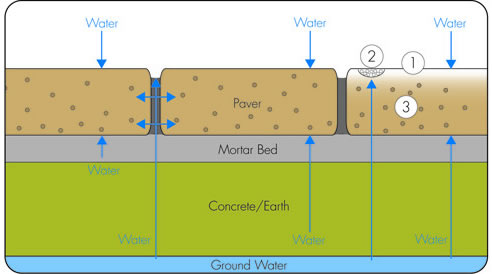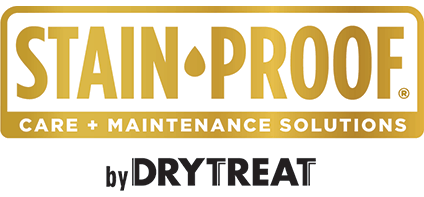Efflorescence Prevention with Penetrating Sealers from Dry-Treat Why are cement based / concrete surfaces more prone to efflorescence? Efflorescence is the unsightly white or yellowish mineral deposits often found on the surface of porous building materials. Efflorescence most often occurs on paving, tiling, poured concrete and other outdoor flooring surfaces (although it is possible for efflorescence to occur indoors). Mineral deposits are brought to the surface dissolved in water. Water moves through the pores of porous materials, from wetter to dryer areas, continuously, until it escapes by evaporation. As the visible exposed surfaces are usually the driest due to the sun and air flow, any water from underneath or inside the material will usually find its way to these exposed surfaces, where it evaporates, leaving any dissolved minerals / salts behind as a white or yellowish deposit called 'efflorescence'. Once exposed to the air, efflorescence can harden, becoming difficult and sometimes even impossible to remove. In addition, salt crystals can form and grow just beneath the surface, breaking (spalling) off microscopic pieces of concrete, again and again, until you begin to get visible pits in the material.
Concrete suffers from 2 levels of efflorescence: How do I remove efflorescence from my surface? While efflorescence can usually be removed from the surface, it is a difficult and expensive process, and salt spalling can cause permanent damage, so it is best to limit efflorescence before it occurs, rather than deal with it after it forms. The answer is to seal the surface with a super penetrating, permanent bonding Dry-Treat sealer as soon as it is practical after the building material is installed. The deeper water repellent barrier created by a Dry-Treat sealer keeps water and water borne salts as far away as possible from the exposed surfaces. Dry-Treat sealing technology also has 2 other advantages over other penetrating sealers on concrete: a) The special modified silane sealing molecules are highly alkaline resistant, and concrete is an alkaline environment which will break down other impregnating sealers. b) The smaller molecules in Dry-Treat sealers do not block the pores, and the material retains the highest possible level of breathability after sealing - this high level of breathability is critical to allow moisture to evaporate and escape as a gas from the pores. Other sealers can trap moisture deep inside the material where it can cause concrete cancer and rust any steel reinforcement. STAIN-PROOF Original™ and META CRÉME™ will radically limit efflorescence.
|
STAIN-PROOF by Dry-Treat Profile 1800 786 617 (Toll Free) or (03) 9338 9851 30-32 Assembly Drive, Tullamarine, Vic, 3043
|



 Consolidator & Water Repellent for
Consolidator & Water Repellent for Peroxide Cleaner for Stone and Masonry
Peroxide Cleaner for Stone and Masonry Paver Enhancing Sealer for Driveways by
Paver Enhancing Sealer for Driveways by Gentle Cleaner for Countertops by
Gentle Cleaner for Countertops by Alkaline Cleaner for Natural Stone by
Alkaline Cleaner for Natural Stone by Special Coating for Slippery Floors by
Special Coating for Slippery Floors by Paver Enhancing Sealer for Outdoor
Paver Enhancing Sealer for Outdoor Premium Impregnating Sealer for
Premium Impregnating Sealer for Daily Floor Cleaner for Hard Surfaces by
Daily Floor Cleaner for Hard Surfaces by STAIN-PROOF Premium Impregnating Sealers
STAIN-PROOF Premium Impregnating Sealers Stone Sealers for Travertine by
Stone Sealers for Travertine by Premium Impregnating Sealer and Color
Premium Impregnating Sealer and Color Premium Impregnating Sealer Application
Premium Impregnating Sealer Application Sealing Cement Tiles | Stain-Proof
Sealing Cement Tiles | Stain-Proof Maintaining Sealed Surfaces with
Maintaining Sealed Surfaces with Surface Sealant Basics - Sealers 101 by
Surface Sealant Basics - Sealers 101 by Pool Surround Sealants, Enhancers and
Pool Surround Sealants, Enhancers and Specify Sealants for Polished Concrete
Specify Sealants for Polished Concrete Seal, Enhance and Clean Your Outdoor
Seal, Enhance and Clean Your Outdoor Seal & Protect Natural Stone Facades
Seal & Protect Natural Stone Facades
